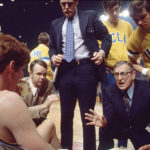Serena Williams fell to her
knees, throwing her head
back with eyes closed,
fists clenched and mouth
open in partial smile. Her
expression was of gratitude,
exhilaration and maybe a little
disbelief. She’d out-powered the
reigning champion, her older sister Venus,
in straight sets to take the 2009 Wimbledon
Ladies Singles Championship.
Embracing at the net, Venus appeared exhausted, her knee bandaged from an
earlier injury. But the victory couldn’t have been sweeter for 27-year-old Serena,
who had lost to Venus in the 2008 Wimbledon Finals. Hours later, the sisters partnered
to win their fourth Ladies Doubles Championship.
Powerful, quick and agile, Serena Williams thrives on winning. Since her
Wimbledon loss last year, when she was less than gracious in a televised question-and-
answer session, she says she’s worked on being a better loser (although she
hasn’t had much opportunity to practice the skill lately). “I used to be really, really
bad and very unprofessional after a loss because I hate losing so much,” she tells
SUCCESS in an interview days after winning this year’s championship. “But I’ve
come to realize that a loss is not the end of the world. I don’t cry as much. I
realize I can’t win everything.
“But don’t think it doesn’t hurt. I’m just learning not to show it,” she says.
“I don’t like it, and what I do is go home and practice harder. I work harder.
I train harder. When I step on that practice court in the days after a loss,
I have an anger in me. It is subconscious. I don’t mean to be that way. But
now I use that anger to make me better. It propels me to work harder.”
Since last year’s loss to Venus, Serena has won three of the last four Grand
Slam tennis tournaments, “and I should have won the French Open, too,” she
says without any hesitation. And with about $24 million earned in her career,
she’s won more prize money than any female athlete in history.
Many Open Doors
“I have always been a perfectionist,” she says. “When I was 5 years old
and in kindergarten, we had a project due and I was up late working on
it, so late that my mom had to force me to go to bed. But I kept getting
back up because I wanted to re-do the project until it was 100 percent
perfect. Eventually, I fell asleep and didn’t get it done because I
wanted it to be perfect more than I wanted to just get it done.”
Unlike that childhood experience, Williams’ perfectionism today
doesn’t seem to thwart her in reaching her goals. Ranked as the
world’s second-best player, she has won 11 career Grand Slams and
become recognized as one of the game’s all-time greats, a stage she
gladly shares with Venus.
Seeing the intensity and power she brings to the game, it’s hard to
imagine her being anything but single-minded in pursuing tennis.
But Serena Williams has other passions, too. In fact, there doesn’t
seem to be enough time in the day, week or month for one of the
world’s most gifted athletes to chase her many interests. When Serena
does decide to walk away from tennis, triumphantly closing one door,
what door will she open next? More accurately, what doors will she
charge through?
Will it be the fashion world? Her designs have graced several
runways, and she’s modeled her designs and others, including swimsuits
for Sports Illustrated.
Or will it be in Hollywood as an actress or writer? Having starred
in a reality show and done appearances on ER and My Wife and
Kids, Serena is writing a TV show storyline she hopes to share with
Hollywood friends next year.
Don’t exclude family life, either. Serena wants to be happily
married with children by her mid-30s.
And she’s also creating a philanthropic legacy, with pet causes
including at-risk children, ovarian cancer research, the Special
Olympics and the newly opened Serena Williams Secondary School
in Kenya. Serena says she wants to use all her talents and skills
to make a difference for others, and says her role models include
Oprah Winfrey. In fact, she reluctantly admits being the next Oprah
Winfrey wouldn’t be bad either. “Who wouldn’t want to be?” she
says, laughing.
Although some have criticized her off-the-court interests as potential
distractions from tennis, Serena says her other vocations probably
made her a better player, particularly attending design school when
she was younger, which stimulated her mind and creativity.
Against the Odds
Born in 1981 to Richard Williams and Oracene Price,
Serena was the baby of five sisters, three of them from
Oracene’s previous marriage. Encouraged by their father,
Venus and Serena were very young when they started
John Russo/Corbis Outline
playing tennis on the public courts of their childhood hometown
of Compton, a Los Angeles suburb better known for crime than
country clubs. When Serena was 9, the family moved to West Palm
Beach, Fla., for better coaching and opportunities to play highercaliber
players. Serena started playing professional tennis in 1995,
a year after Venus turned pro, and won her first professional singles
title in 1999.
As a teen, Serena didn’t pay much attention to clothes. “I always left
fashion up to Venus and everyone else who really had style,” she says.
But Serena always found herself drawing outfits on scraps of paper.
She sketched designs on long plane trips and between tournaments.
With a polite nudge from Venus, who after high school enrolled
in college courses at The Art Institute of Fort Lauderdale, Serena
followed “Big Sis” and enrolled in the same school.
“Instead of playing tennis, watching television, playing tennis,
watching television, I accidently found a new place for my creative
energy,” Serena says. “Honestly, I think I would have been an average
tennis player if I hadn’t gone to school. I was wasting away watching
television. School was work, but it was fun.”
Serena studied fashion design, spending most of her course time
sewing and drawing, learning the construction of garments and
gaining an understanding of the manufacturing end of the design
business. “I know design. I love design. I know how to make patterns
work. It’s just something that I love and it’s something I developed a
real, deep appreciation for,” she says.
Meantime, Venus also pursued careers in fashion and interior
design, developing her own EleVen clothing line and opening her
own V Starr Interiors design company in Florida.
Coming into Her Own
Although Serena had been influenced by her sister
in many ways, including fashion, she says fashion also
allowed her to make a personal statement. She started
developing her own style with adventurous, eccentric
and fun outfits. (Who can forget the black Lycra catsuit
she wore in the 2002 U.S. Open or the white trench coat
worn at Wimbledon this year and last?) In her book On
the Line, scheduled for release in September, she explains
how fashion also helped her in tennis, as she realized that
presenting her best image on the court helped project a
positive picture to the world.
Serena debuted her Aneres clothing line in 2003 and
premiered her Aneres Clothing Collection the following
year. Coming up with the name, which is Serena spelled
backward, was an empowering moment. “I was like, ‘Wow,
I can pronounce it and it doesn’t sound stupid,” she laughs.
“I knew then I could chase my dreams outside of tennis, be
it my clothing company, jewelry, a production company—
there are so many neat and wonderful things out there.”
At one point, Serena had a line of tennis clothing with
Puma and now has a line with Nike thanks to a deal signed
in 2004 worth $40 million that allows her to work alongside
the company’s development team. At Wimbledon this
summer, Nike remastered the trench coat for her to wear
during warm-ups and to walk on and off the
court. The feminine white court dress she wore
also was from Nike.
“I
am so lucky. Being a tennis player,
every tournament I play gives me a great
opportunity to market whatever I am
working on or wearing,” Serena says.
“It gives me the platform that allows
people to see it firsthand and allows
them to make a decision on whether
they like it or not. I want people to
feel confident that if they are buying
an item from Nike or a product that
I designed or represent, it’s a good
product because you associate it
with me.”
Bucking the Critics
Serena is selling her active wear
fashion line in boutiques in Miami
and Los Angeles. Last April, she
made the leap to infomercials on the
Home Shopping
Network when she launched a signature
collection of everyday dresses, tops, handbags and
jewelry. Scheduled
to return to HSN in September and
November, Serena
says the items priced at $100 or less
immediately connected with consumers.
“I felt so honored that everyone wanted to try them and
wear them,” she says. “Being an athlete, I only have to
satisfy myself. If I go on the court and either win or lose,
it’s only about me. But being a designer, I really want to
make people happy and I want them to be happy with
what I make.”
Some in tennis would disagree with Serena’s assessment,
saying her athletic talent conveys greater obligations.
Tennis legends Martina Navratilova and Chris
Evert have said they don’t believe Serena can reach her
potential when her commitments are strung out like a
volley being played from all corners of the court.
“Serena is designing dresses, and I feel she wants to be
an actress more than a tennis player,” Navratilova said in
a 2007 interview.
Evert was more direct, much like an overhead slam at
the net. “In the short term, you may be happy with the
various things going on in your life, but I wonder whether
20 years from now you might reflect on your career and
regret not putting 100 percent of yourself into tennis,”
Evert wrote to Serena in an open letter three years ago.
“Because whether you want to admit it or not, these
distractions are tarnishing your legacy.”
Tennis First
If Serena has been distracted, her record doesn’t show
it. Earlier this year, she declared herself the world’s best
player, even though Dinara Safina was ranked No. 1.
And Serena’s record backs up her bravado; ranked No.
1 in the world by the Women’s Tennis Association on four
separate occasions, she’s the only active female player to have
won all four Grand Slam tournaments during her career—
one French Open, three Wimbledon, four Australian and
three U.S. Opens.
Serena says she’s not bothered by Evert’s and Navratilova’s
critical evaluations of her career, or by others who have
hinted she’s spread herself too thin or that her goals outside
of tennis are unreasonable. “I think everyone is entitled to
their opinion, and they truly might think that I don’t need to
do all these other things,” she says. “Honestly, I am honored
that they are even concerned about how I am playing. I
mean, hey, they really want me to do well. I just think when
you are given a great opportunity and you have the chance
to do other things, you need to follow your dreams and try
to make the most of your opportunities.”
Serena doesn’t even read her own press, she says,
although she does have a scrapbook full of articles,
“and I plan to go back and read them once I’ve
stopped playing. I don’t play for [writers or critics],
and I don’t want their opinions impacting me now.”
And at the front of the line right now, Serena says,
is her first love, tennis. Serena Williams knows that
results on the court define her as a tennis player.
Although she may not have the time to concentrate
on her outside interests as much as she’d like, that day will
eventually come. And Serena will be ready.
“I don’t really care whether my stuff is [financially]
successful, I just want people to like it,” she says.
“I am not doing anything for money. I am doing it
because I love it. Anyone who knows me knows that I
live a simple life and enjoy the simple pleasures of being
happy and making people happy. That’s really what all this
is about.”
Don Yaeger is a New York Times best-selling author, former Sports
Illustrated associate editor and award-winning speaker.







